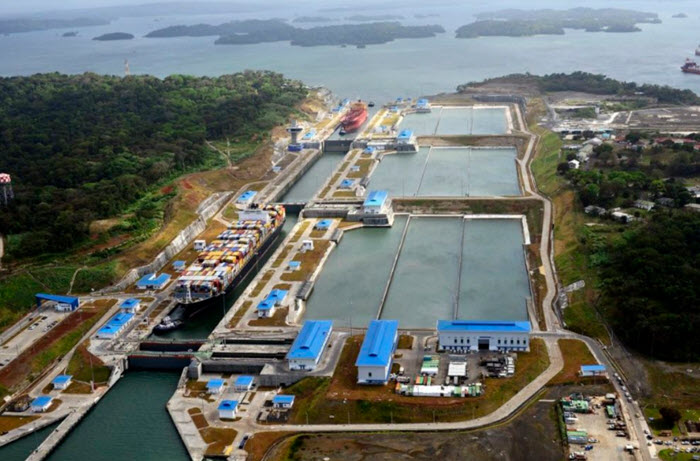Today, the Panama Canal celebrates two decades under Panamanian administration. While the waterway was already an important trade route and engineering marvel, its transfer to the Panamanian people at noon on December 31, 1999, set in motion a redefining period not only for the Panama Canal, but also Panama itself
Over the next 20 years, the Panama Canal transformed from a profit-neutral utility to a competitive, innovative business. With the country’s support, the waterway modernized and optimized service, upholding its commitment to enabling global trade and local growth. Meanwhile, its world-class workforce drove positive change across the industry and strengthened the country’s rising role as a global logistics hub.
The Panama Canal’s achievements over the past twenty years have come to embody its Panamanian leadership, marked by its ability to take on seemingly impossible challenges and exceed expectations. While the industry continues to face an increasingly complex operating landscape, the waterway celebrates its transformation to-date and remains committed to tackling challenges with ingenuity, courage and imagination, just as it did 20 years ago.
To mark its 20th anniversary under Panamanian leadership, the waterway proudly looks back at a few key achievements from the past 20 years:
1 The Panama Canal Modernization and Improvement Program intensified, aimed at upgrading infrastructure and equipment at the waterway.
2 The Panama Canal adopted a new toll structure, recognizing the increasingly diverse traffic passing through the waterway and replacing the structure that had been in place since its opening.
3 After five years and more than a hundred studies, the Panama Canal presented its Expansion Program proposal. Six months later, over three-quarters of Panamanians approved of the proposal in a national referendum.
4 In September 2007, the Panama Canal began the construction of the new lane of traffic with two new lock complexes, prompting investments in similar expansion projects around the world, particularly along the U.S. East Coast. The Project Management Institute later recognized the Expansion as one of the top 50 most influential projects of the last 50 years.
5 The Panama Canal launched a reforestation and conservation programs, which to-date is responsible for over 2 million planted trees in the Canal’s Watershed and other parts of the country.
6 Less than 10 years after the transfer, transit time (Canal Waters Time) decreased from 33 to 23 hours, marking the growing efficiency and reliability at the Panama Canal.
7 In June 2016, the Expanded Canal was inaugurated in front of 25,000 Panamanians, Canal employees, heads of state and dignitaries from around the world, Canal customers, shipping and trade executives, and nearly 1,000 journalists. That same month, the waterway welcomed its first liquefied natural gas (LNG) vessel, marking the start to the new segment at the Panama Canal.
8 The Panama Canal launched the Green Connection Environmental Recognition Program, recognizing customers who demonstrate excellent environmental stewardship. It includes the Green Connection Award, Emissions Calculator and Environmental Premium Ranking, the latter of which the OECD regarded as “an innovative idea” that “could be much more widely applied in ports.”
9 By the Expanded Canal’s first anniversary, the waterway had welcomed more than 1,500 Neopanamax vessels, surpassing tonnage and daily transit expectations.
10 The waterway installed a floating solar panel park pilot program on Miraflores Lake—the first of its kind in Latin America. The solar panels have 20 kilowatts of peak capacity and cover 400 square meters of water that would normally go unused.
11 By the Expanded Canal’s second anniversary, the Panama Canal increased its maximum allowable beam and daily reservation slots for vessels travelling the Neopanamax Locks, as a result of the considerable experience gained by the waterway’s workforce.
12 Standard & Poor’s (S&P) Global Ratings updated its outlook on the Panama Canal from ‘stable’ to ‘positive’ and affirmed its ‘A-’ rating in recognition of the waterway’s strong performance and global impact. The next year, Moody’s Investors Service upgraded the Panama Canal’s long-term rating to A1 from A2 with a stable outlook, and Fitch Ratings affirmed the Panama Canal’s ‘A’ investment grade rating with a stable outlook for a fourth consecutive year.
13 Four LNG ships successfully transited the Neopanamax Locks in a single day, marking a milestone for the new segment at the Expanded Canal.
14 The Panama Canal became the first Latin American organization to join the Global Industry Alliance, consolidating its position as an environmental steward for the shipping industry.
15 In its first 105 years, the Panama Canal helped reduce 800 million tons of CO2 emissions, a figure accelerated by the shorter traveling distance and larger cargo carrying capacity offered by the Expanded Canal.
16 The iconic Atlantic Bridge was constructed over the Panama Canal and opened, becoming the world’s longest pre-stressed concrete cable-stayed bridge.
17 More than three years after its inauguration, the Expanded Canal continued to set records, welcoming the transit of the first Q-Flex LNG tanker and the largest containership to-date exceeding the 15,000 TEU threshold in August 2019.
18 Thanks to Expanded Canal, in 2018 the Panama Canal welcomed Norwegian Bliss, the largest passenger vessel to ever transit the waterway. The Norwegian Bliss can carry nearly 5,000 passengers.
19 The Panama Canal launched its Environmental Economic Incentives Program (PIEA), which engages local communities in the watershed region through reforestation, environmental education and economic incentive initiatives, and delivered over 8,000 land titles in its first few years.
20 Less than 20 years after the transfer, the Panama Canal had come to welcome 8,000 Neopanamax vessels and connect 144 routes and 1,700 ports across 160 countries.
